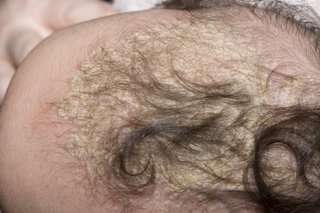Cradle cap is a harmless skin condition that's common in babies. It usually clears up on its own, but there are things you can try to make it better.
Check if your baby has cradle cap

Credit:
DR P. MARAZZI/SCIENCE PHOTO LIBRARY

Credit:
Biophoto Associates/SCIENCE PHOTO LIBRARY

Credit:
Enid English / Alamy Stock Photo
Cradle cap is not itchy or painful and does not bother your baby.
It's not clear what causes cradle cap. It cannot be caught from another baby.
Things you can try to get rid of cradle cap
Do
- wash your baby's hair regularly with baby shampoo and gently loosen flakes with a soft brush
- gently rub on baby oil or a vegetable oil (such as olive oil) to soften the crusts
- use baby oil, vegetable oil or petroleum jelly overnight and wash with baby shampoo in the morning
Don't
- do not use peanut oil (because of the allergy risk)
- do not use soap
- do not use adult shampoos
- do not pick crusts – this can cause an infection
Information:
Hair may come away with the flakes, but do not worry, your baby's hair will soon grow back.
You can ask a pharmacist:
- about cradle cap treatments
Page last reviewed: 24 January 2019
Next review due: 24 January 2022
